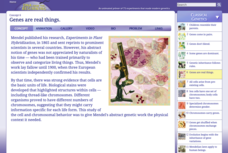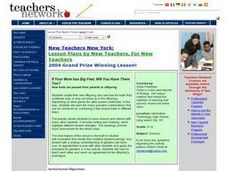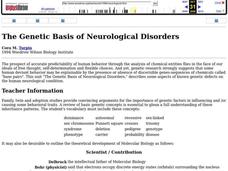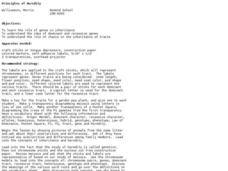Curated OER
Parental Genes
Eighth graders explore how different organisms pass their traits to their offspring. In this life science lesson plan, 8th graders differentiate recessive and dominant alleles. They predict the phenotype based on the genotype of an...
Cold Spring Harbor Laboratory
Genes Are Real Things
Proving microscopic structures exist is a difficult task. Learn how scientists did just that in the mid-1800s as they set out to identify the cellular structures related to genetics. The online lesson explains the collection of work that...
Curated OER
Human Inheritance
Learners analyze genetic characteristics in a given family tree through the F2 generation. Students apply prior knowledge from Gregor Mendel's study with pea plants and his Laws of Heredity to answer questions.
Curated OER
If Your Mom Has Big Feet, Will You Have Them Too?
Learners describe and apply the Mendellian principles of genetics, focusing predominantly on dominant and recessive genes. They demonstrate how two parents contribute genes and how those genes appear in their offspring. They describe...
Curated OER
Designer Babies
Students differentiate phenotypes and genotypes. In this genetics instructional activity, students complete the punnett square. They design their own baby by choosing the phenotype they want.
Curated OER
Mechanisms of Evolution
In this evolution learning exercise, students will answer questions about population genetics and the theory of evolution of species. This learning exercise has 15 true or false, 6 fill in the blank, and 4 short answer questions.
Curated OER
The Genetic Basis of Neurological Disorders
Students describe some aspects of known genetic defects on the human neurological condition. They participate in a variety of exercises including drawings, games, and analogies.
University of Georgia
Monohybrid Crosses and The Punnett Square Lesson Plan
Looking for a quick, hands-on activity to teach young scientists about Punnett squares through monohybrid crosses? then check out this one.
Curated OER
What Should I know for the Test?
A three-page quiz about genetics, which includes Punnett squares, blood types, questions about Mendel and his contributions, and vocabulary comprehension. Use this for a study guide, a pretest/post-test, or a note-taking learning...
Curated OER
Evolution of Biotechnology Timeline
Students explore how present biotechnology has evolved. They create a timeline is included referencing major scientists and major events in history which have led to our current understanding and use. A teacher time line is included.
Curated OER
The Genetic Basis of Neurological Disorders
Students explore neurological disorders. They examine the presence and absence of discernible genes. Students describe neruological diseases and draw faces of affected persons. They play a human neurology disorders learning game.
Curated OER
Applying the Laws of Inheritance
Biology and mathematics can be integrated through a study of Mendelian Genetics.
Curated OER
Case Studies
Students apply their knowledge of "I Values " and have mastered the use of the "Decision Making Model," they are ready to study case studies. They use case studies use to figure out punnet squares, and family traits.
Curated OER
How Do Organisms Vary?
Students study variation of organisms. They determine this variation arises from genetic and environmental causes.
Curated OER
Disproving the Proof
Students investigate the progression of discoveries that have led to the genetics knowledge that scientists currently have. They determine how genetic experiments disproved previous theories on inheritance.
Curated OER
Heredity: Your Connection To The Past
Students investigate genetics and the process of reproduction in living organisms.
Curated OER
Ladders of Life
High schoolers explore the field of genetics. They examine four basic traits. Students demonstrate their knowledge of phenotype and genotype by charting their personal traits. High schoolers compelte a Meiosis chart. From the chart...
American Museum of Natural History
Nature or Nurture Quiz
Eighteen questions ask pupils whether certain behavior or trait is based on nature or nurture. Scholars take a quiz, reflect on their answers, then challenge a friend or family member to complete it.
Curated OER
History of Biotechnology
Ancient, classical, and modern methods of biotechnological methods are introduced in this science PowerPoint. Students should be interested to see how advanced people have been through the ages in adapting their methods to procure...
Cold Spring Harbor Laboratory
Sex Cells Have One Set of Chromosomes; Body Cells Have Two
What's the difference between body cells and sex cells? Learners explore the question and the process of meiosis using an interactive lesson. An animation describes the discovery of meiosis and describes its phases for a detailed and...
Curated OER
The Hardy-Weinberg Equilibrium
Students act out a drama in this instructional activity on one aspect of the Hardy-Weinberg Equilibrium. They are to follow all stage directions precisely and give it their best effort to get across the main points of the play.
Curated OER
Pea Plants Dihybrid Cross
In this dihybrid cross worksheet, students are given four crosses to complete using punnett squares. They determine the genotypic and phenotypic ratios of the offspring.
Curated OER
Dihybrid Cross Punnett Squares
In this dihybrid cross worksheet, students complete two punnett squares for the cross of two traits. They determine the genotypes, phenotypes and phenotypic ratios of the offspring.
Curated OER
Principles of Heredity
Students model traits on genes using colored paper and tongue depressors to represent chromosomes. In this heredity lesson plan, students use their "chromosome sticks" to understand chromosome pairs, genes, dominant traits, recessive...
Other popular searches
- Mendelian Genetics
- Mendel Genetics
- Mendelian Genetics Problems
- Mendel Genetics Review
- Mendelian Genetics Quiz
- Mendel Genetics Practice
- Mendel Genetics Concept Map
- Non Mendelian Genetics
- Mendel Genetics Create
- Mendelian Genetics Parents
- Mendelian Genetics Games
- Mendelian Genetics and Peas

























